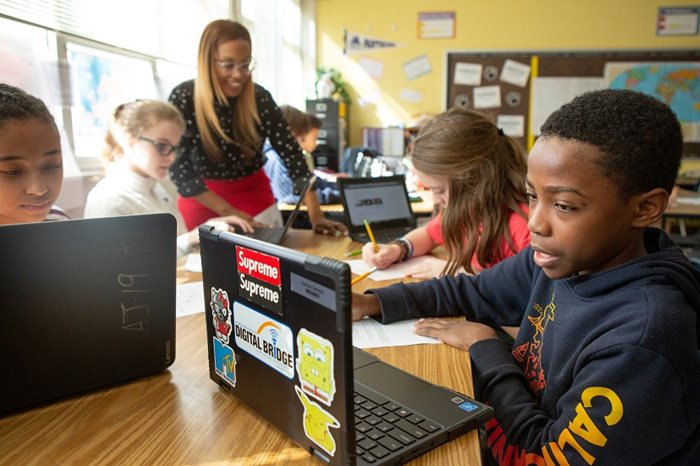Culturally Responsive Education
NMSI |
June 16, 2022
Original Published Date: 10.19.2021. Updated: 6.16.2022
The term cultural diversity is bandied around a great deal. Community organizations talk about it. Businesses work hard to weave the practice into their corporate fabric. Politicians sprinkle it liberally in their words and, hopefully, into their actions. It’s also joined a long list of education buzz words - social-emotional learning, accessibility, equity, synchronous and asynchronous learning and inclusion.
But cultural diversity isn’t simply a current trend or a fashionable philosophy; it’s a proven necessity for success in a global environment. Research shows that cultural diversity has a powerful impact on an organization’s bottom line. For example, those who take a culturally responsive approach are 21 percent more likely to get better financial returns.
Compelling research highlights the benefits of culturally responsive teaching. For instance, Zaretta Hammond’s book, Culturally Responsive Teaching and The Brain: Promoting Authentic Engagement and Rigor Among Culturally and Linguistically Diverse Students, points to neuroscience evidence that cultural values and learning practices transmitted from parents and the community guide how the brain wires itself to process information and handle relationships.

Defining Culturally Responsive Education
Culturally Responsive Education is a research-based approach to teaching that recognizes culture is central to learning. It connects students’ cultures, languages and life experiences with learning in school. It plays a role in how information is communicated and received and shapes the thinking process of groups and individuals.
At its core, CRE ensures that educators and the education system meet all students’ needs.
CRE Addresses the Systemic Inequities of the “Achievement Gap”
There’s much discussion in education about the achievement gap between white students and students of color, particularly Black and Hispanic students. But the term “achievement gap” doesn’t adequately acknowledge systemic inequities or effectively address it.
Traditional education maintains the status quo, placing an undue burden for learning completely on students. Culturally responsive education instead provides a method to close the opportunity gap by asking that educators hold high expectations for all students and puts the onus on the system and adults to ensure all students have access to supports for success.
When thinking about culture and diversity, people often automatically think about Black or Latino students, but it goes beyond that. Culturally responsive education strategies aren’t just for students of color; everyone needs to learn about diversity.
CRE Is a Powerful Way to Reach Students and Has Multiple Benefits
Research shows that culturally responsive teaching promotes social, emotional and academic development of all students by:
Motivating and Engaging Students
Culturally responsive education connects academic concepts to students’ everyday lives, making learning experiences more personally meaningful, engaging and effective. It also establishes trusting relationships between students and their teachers.
For instance, one study discovered that participating in an ethnic studies course that emphasized cultural affirmation was associated with improved attendance and GPA (grade point average) gains. In addition, a smaller-scale study reported that Black students who participated in a culturally relevant mathematics course felt more motivated to engage in mathematics and more confident about taking standardized tests.
Facilitating Brain Processing
Earlier studies found that drawing from students’ cultural knowledge and norms contributes to reading comprehension and mathematical thinking. Neuroscience research explains that people learn new information best when linked to what they already know. In other words, using texts, materials and examples that draw from students’ cultural and background knowledge makes learning more accessible because it leverages students' existing neural pathways.
Neuroscience research also shows that culture drives how brains process information; for example, students who share strong oral traditions are primed to learn new information best through music and storytelling. Likewise, when culturally responsive education uses repetition, rhythm, movement and visuals during instruction, it also strengthens neural comprehension pathways.
Cultivating Critical Thinking and Problem-solving Skills
Culturally responsive education can also help build student awareness of social injustice issues they may encounter in their daily lives and communities. It can facilitate their abilities to analyze, formulate questions and generate solutions to challenging problems. For example, one case study describes the efforts of a group of students investigating zoning laws that negatively impacted their community and used critical thinking to solve the problem.
Strengthening Students’ Racial and Ethnic Identities
Studies have shown that racial and ethnic pride can be linked to school engagement, interest in learning and improved grades. Other research found that a stronger racial identity can diminish the effects of racial discrimination and stereotyping (e.g., the concept that individuals can perform worse on assignments than they might otherwise when they feel they are living up to a negative stereotype).
Conversely, there is also evidence that confusion, ambivalence and anxiety about their racial identity can zap students’ engagement and, in turn, derail their academic performance.
Promoting a Sense of Safety and Belonging
Studies have shown that a sense of belonging, safety and school support is critically important for learning. Many of the culturally responsive teaching management strategies - encouraging socialization among students, establishing respectful relationships with students and demonstrating care - create a sense of belonging and affirmation for students’ cultures and the culture of others.
Incorporating culturally responsive education into your schools and classrooms may sound daunting. It’s a significant sea change that can’t be accomplished overnight, but there are ways to implement essential changes.

Suggestions for School Administrators
-
Provide substantial professional development opportunities on cultural competence, equity and social justice for teachers and staff
-
Invest in leadership training through National Math and Science Initiative’s Leadership Development Workshop
-
Review your language policy to ensure your school is offering appropriate translation for families. Consider incorporating graphic components for those who are visual learners
-
Hold some family events outside of school hours to allow working families to attend
-
Assess whether your student dress code welcomes different hairstyles and expressions of self
-
Explore innovative ways to reach the surrounding community, especially families, to utilize their strengths, keep them informed and involve them in creating and sustaining a positive climate and culture
Suggestions for Teachers
-
Make learning contextual. Tie lessons from the curriculum to the students’ social communities to make them more contextual and relevant. For example, if you’re reading a chapter in history class, discuss why it matters today. Take the concept you’re teaching and create a project that enables students to draw parallels.
-
Encourage students to leverage their cultural capital. Because not all students come from the same background, it’s essential to encourage those who don’t have a voice. For instance, if you teach an English class that includes ESL students, find ways to activate their experiences - their cultural capital - by choosing a book to read that the ESL students can relate to and feel they have some expertise in the subject.
-
Reconsider your classroom set up and assignments. For example, does your inventory include authors of diverse races? Is the LGBTQ community represented? Do the books feature urban families or only suburban families? Beyond your classroom library, consider the posters you display on your walls and your bulletin boards, too. These small changes can go a long way to make your classroom more culturally responsive.
-
Build relationships. Teachers need to build relationships with their students to ensure they feel respected, valued and seen. Building these relationships helps build community within the classroom and with each other.
Every school is unique, so we encourage you to use the ideas in this post as a guide. Educators have the power to impact their students long-term with thoughtful, inclusive instruction. NMSI is committed to supporting schools on their path toward equitable education.